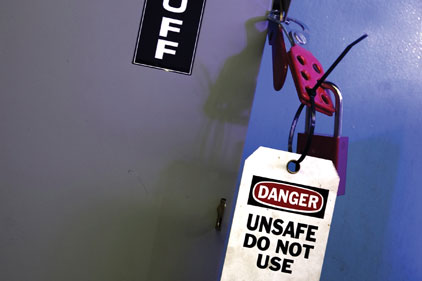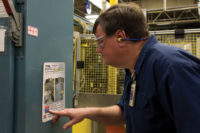An approach to LOTO instructions and training

Worker safety relies on the rare tandem of key integrity and precise lockout procedures. Depending on the type of facility, this usually involves machines and a host of production equipment. Items such as pumps, boilers, air handler units and hot water heaters have multiple energy sources — electrical, water, gas, steam — or different power connections like circuit breakers, valves and plugs.
At the same time, often overlooked is the simple method of assuring there is no key interchange where one employee’s key opens another worker’s safety lockout padlock. The common belief that key cuts are unlimited, and keys thus are inherently unique, is not accurate. The number of cuts is directly related to the number of pins (4, 5 or 6) in the cylinder and the combinations they create. I’ve seen ranges from 1,440 unique cuts from a small, 4-pin cylinder, to a 6-pin safety exclusive cylinder that offers over 40,000 different cuts.
Click here to view more articles about LOTO |
When it’s decision time, choose padlocks with dedicated-to-safety keyways so security padlock keys won’t work. Also, choose locks with more unique key cuts than a facility needs. That helps with new orders using unique keys and allows for future growth without duplicating keys. It also makes sense to purchase from a manufacturer who keeps detailed records of the key cuts for each facility. That’s important since those future orders are built on the next sequence of key cuts without repeats, unless the facility authorizes it; say for example, additional locks for a current employee.
Key integrity should go hand-in-hand with any lockout situation. OSHA regulation 1910.147 (The Control of Hazardous Energy) requires companies to train employees on lockout/tagout (LOTO), which triggers a series of events. The company can benefit from increased productivity by reducing or avoiding worker injuries or equipment damage and cutting time devoted to LOTO and maintenance. However, LOTO instructions are sometimes too general or vague by nature and can be unclear for the authorized employee performing LOTO.
Steps and guidelines that cover the field, avoid dangerous omissions
For simplicity’s sake, be methodical in your approach to LOTO instructions and training. Keep these steps in mind to execute safety procedures:
- Shutdown preparation begins by specifically noting the types, magnitude and hazards of the energy you need to control, and how. Visual procedure signs and instructions mounted on or near each piece of equipment not only will identify all of the energy sources that need to be locked out, but location of each lockout point and the lockout device needed as well.
- Employees who are affected by the shutdown need to be notified and informed that LOTO is beginning.
- When shutting down the machine or equipment, turn off energy points in the correct sequence. This will prevent equipment damage and avoid creating other potential hazardous situations.
- Isolate the units from energy sources by de-activating the valves and disconnecting switches, circuit breakers and any other energy sources.
- Lock out and apply locks — often with lockout devices — to hold switches and valves in the “safe” or “off” position. Also, make sure to secure each and all power sources.
- When releasing stored energy, bleed off the pressure and drain the lines and any blocked elevated parts. Small amounts of residual air, gas, steam, water pressure or energy in the capacitors, springs or hydraulic systems can pose hazardous complications.
- When verifying lockout, make certain that no employees are exposed. Only then should you test the machine controls to confirm a zero-energy state.
When restoring equipment after servicing, it’s important to check all of the equipment and surrounding areas to make sure nonessential items have been removed and the equipment is correctly reassembled. Next would be to notify and confirm all of the employees in the area are safely positioned. After verifying the controls are in neutral, remove the lockout devices and reenergize the equipment but realize that removing some blocking devices may require reenergizing first.
Using specifically designated LOTO devices and padlocks — which are different than locks used for security purposes — and identification labels, tags and signs will alert workers that LOTO maintenance is in progress. For both domestic and international equipment maintenance situations, there may be language requirements to consider, so use signage the workforce can read and understand. Photo ID labels are an absolute consideration to help verify which workers are performing specific maintenance routines.
Several manufacturers provide a LOTO device for almost every need.
However, there are two essential items that rank high for consideration:
1) Multi-fit devices that lock out several sizes or types of energy-source control. This also results in needing fewer devices to carry in order to perform the lockout. Choose circuit breaker lockouts, where one model fits both standard height and tie-bar toggles typical of 120 and 240 volt breakers, while another fits wide or tall breakers common with high voltage-high amp controls. And select valve and pneumatic devices that have the flexibility to lock out virtually every size valve or fitting.
2) Space-savers that work in tight quarters. This includes rotating devices that effectively surround and lock out a plug or valve while pivoting open to half the size for storage, and compact devices that lock out valves close to walls, other pipes or tough-to-reach locations.
Following these steps not only will expedite LOTO but will help ensure OSHA compliance and improve the odds of having a safe environment.
Looking for a reprint of this article?
From high-res PDFs to custom plaques, order your copy today!





